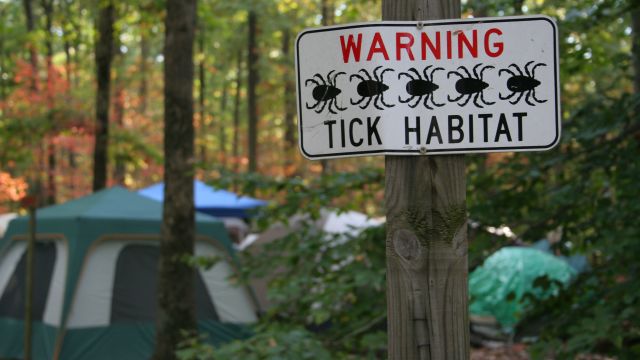Updated on July 17, 2024.
In the 1970s, children in the area around Lyme, Connecticut, began to develop odd, unexplained symptoms after playing in the woods. The issues included swollen knees, skin rashes, headaches, severe chronic fatigue, and paralysis, in some cases. The problems tended to show up after the kids were bitten by blacklegged ticks, also called deer ticks.
The source of the symptoms remained unclear until 1982. That year, a medical entomologist (a scientist who studies insects) named Wilhelm “Willy” Burgdorfer, PhD, published a study. Wilhelm and his coauthors found that a corkscrew-shaped bacterium called Borrelia burgdorferi that is carried by deer ticks caused the condition described as “Lyme disease.”
Deer ticks are about the size of a poppy seed when they are still young, during the spring and summer. That’s when they are most likely to cause an infection when they bite someone if they are carrying the bacteria.
“They’re very small and very hard to see,” explains Reid Blackwelder, MD, a professor of family medicine at East Tennessee State University in Johnson City.
A tick bit me. Now what?
“People think that every tick has Lyme disease,” Dr. Blackwelder says. “But the infected ticks are only in certain places.” Most cases of Lyme disease in the United States have come from bites in one of these 16 states or districts:
- Connecticut
- Delaware
- Maine
- Maryland
- Massachusetts
- Minnesota
- New Hampshire
- New Jersey
- New York
- Pennsylvania
- Rhode Island
- Vermont
- Virginia
- Washington, D.C.
- West Virginia
- Wisconsin
Even in locations where Lyme disease is common, only about 50 percent of ticks carry Borrelia burgdorferi bacteria. That said, you should suspect Lyme disease after being bitten by a tick if:
- You live in an area with infected ticks
- You have symptoms that occur during tick season (which lasts during the warm months, from around April to September)
So what symptoms should you look for?
The telltale sign of Lyme disease
After being bitten by a tick, you might notice a small bump with redness or discoloration at the site, much like you’d see if a mosquito had bitten you. Having this rash from a tick bite doesn’t necessarily mean you’ll contract Lyme disease. According to the American Lyme Disease Foundation, only one to five percent of tick bites will cause a Lyme disease infection.
The most obvious sign of Lyme disease to look for is a rash shaped like a bull’s-eye. It’s known as the “erythema migrans” rash. It doesn’t show up immediately after a bite. Instead, it appears in three to 30 days, but typically after seven days on average, according to the Centers for Disease Control and Prevention (CDC). It can expand to up to 12 inches across, and as it enlarges, it often has a clear area in the center, creating the bull’s-eye appearance.
Generally, if a physician sees the classic bull’s-eye rash, you’ll receive a course of antibiotics for 10 to 14 days.
What if I don’t have a bull’s-eye rash?
To add to the complexity of Lyme disease, in 20 to 30 percent of Lyme cases, you won’t see any rash, according to the CDC. Scientists don’t know why some people get the rash and others don’t, Blackwelder says.
Other than the bull’s-eye rash, early symptoms of Lyme disease aren’t distinctive. You might feel like you have the flu and have symptoms like fever, swollen lymph nodes, chills, headache, fatigue, or muscle and joint pain. Those symptoms can also come from other infections, including those caused by viruses, Blackwelder notes.
So what if a tick bites you, you don’t see a rash, and you don’t experience any other symptoms?
“You can probably relax and forget about your tick bite,” says Blackwelder. If you were bit by a tick and didn’t get a rash but had flu-like symptoms that went away, then you probably don’t need to worry, either. You may have had a bout of the flu or allergies, he says.
What should I do if I have symptoms?
If you are experiencing classic Lyme symptoms like the bull’s-eye rash, fever, chills, and headaches, don’t put off seeing your healthcare provider (HCP). Early treatment is best for Lyme disease.
As time goes on, untreated Lyme disease can spread to the nervous system. If the condition does spread, you might develop dizziness, numbing or tingling in the hands and feet, heart palpitations, severe headaches, or a facial droop, the CDC notes.
At that point, which can occur months or years later, you may need to receive intravenous (through-the-vein) antibiotics. “It’s still curable in a later stage, but there may be damage that doesn’t go away,” Blackwelder adds.
Sometimes after diagnosis and treatment for Lyme disease there may be lingering symptoms. These aren’t well understood, but according to the CDC, about five to 10 percent of people will have prolonged symptoms, including difficulty thinking, aches in the body, and fatigue. If this happens, it’s important to consult with your HCP. They can help you make sure the symptoms don’t have another cause and find ways to address them.
Could I have ‘chronic Lyme disease’?
Sometimes, a person may not test positive for Lyme, but because they have ongoing symptoms, they may believe they have a condition that’s been called “chronic Lyme disease” that doesn’t show up on tests.
“If all the lab tests are negative for Lyme disease, I would be thinking of some other disease or process,” Blackwelder says. “It could be another infection, including ones caused by viruses, another immune condition, or even something like multiple sclerosis. Basically, at this point, you need to see a doctor and sit down and figure it out.”
6 ways to prevent tick bites
You can avoid tick bites by taking a few precautionary measures. Here’s how the CDC says to keep yourself safe from ticks all year long, and especially during warmer months when ticks are more active:
Stay on the path. When walking or hiking, avoid high grass or brush areas, or areas with leaf litter. Walk in the center of the trails. Avoid trail edges.
Use bug spray. Pick a tick repellent that contains one of the following ingredients:
- DEET
- Picaridin
- IR3535
- Oil of Lemon Eucalyptus (OLE)
- 2-undecanone
- Para-menthane-diol (PMD)
Always read and follow application instructions.
Dress for prevention. Always wear closed-toed shoes. Don’t go barefoot or wear open-toed shoes on trails or in woody, grassy areas. Wear long-sleeved shirts and pants and tuck pants into shoes and socks. Treat your clothing—like socks, shoes, and pants—with anti-tick products that contain 0.5 percent permethrin.
Clean up. Take a bath or shower within two hours after being outside. This will help you possibly find and remove ticks.
Check yourself (and your loved ones). Do a full-body tick check after being outside in tick-populated areas. Parents should check their kids for ticks, too. A good tick check includes looking under the arms, around and inside the ears, backs of knees, between legs and around the waist, as well as around the hair and scalp, and in the belly button. Check pets for ticks, too, as well as gear like bags and jackets.
The bottom line: If you are bitten by a tick and aren’t feeling well, see an HCP right away. They can explore your medical history, conduct a physical exam, and consider whether a lab test is a logical next step, says Blackwelder.







